This post may contain affiliate links. As an Amazon Associate I earn from qualifying purchases.
* * *
Out of all the foods in the world, rice is one of my least favorite things to eat. It ranks right up there with fruitcake and SPAM. I avoid it as much as possible, but in Laos, rice is life. They eat it breakfast, lunch, and dinner, so I figured I might as well make an effort to learn about it.
Just because I don’t like to eat rice doesn’t mean I don’t appreciate a good activity. And so I found myself taking a tuk-tuk one morning to a rice farm about twenty minutes outside of Luang Prabang. Here, Laut Lee has organized a community enterprise for growing rice — and for educating local farmers about sustainable farming techniques.
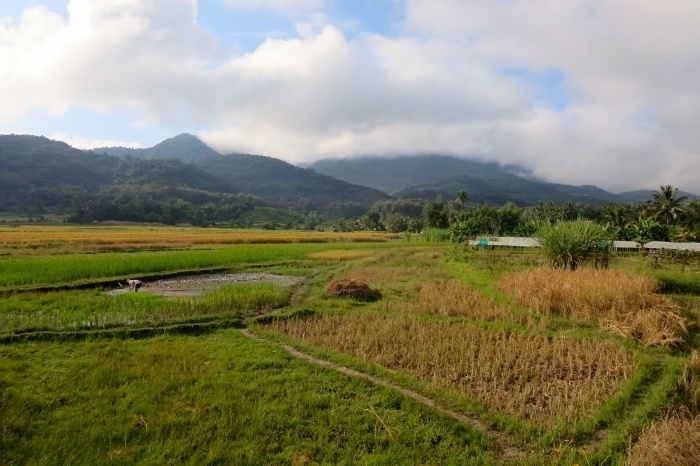
A few years ago, Laut Lee also started teaching travelers how rice is grown, harvested, and cooked. On a warm, sunny morning, he explained that everything on the farm is done sustainably, organically, and by hand, the way it had been done for generations. We’d learn 14 steps in all and were encouraged to participate in the fields throughout the whole process. Because the only thing smarter than growing your own rice is charging tourists to do the work for you.
Just kidding! Laut Lee shares this knowledge because of his enthusiasm for traditional Lao culture and not for the free labor. Besides, as I was about to find out, everything is harder than it looks and it probably takes longer to clean up after tourists than it would to just do everything themselves!
Gathering around, we started our lesson on growing rice.
The 14 Steps to Planting, Growing, Harvesting, and Preparing Rice
1. Selecting the Grain
When one harvest is over, the next one begins immediately. About 1% of the grains are set aside and saved to be used as seeds for the next round. To find the best grains, they’re placed in a saltwater solution: the sinkers are deemed healthy and good for planting. The salt is rinsed away in preparation for planting and the “bad” grains are given to livestock as feed.
2. Planting the Seeds in a Nursery
Not surprisingly, the second step to growing rice is actually planting the seeds. They use a nursery to make sure that conditions are perfectly controlled while the rice is still particularly susceptible.
3. Ploughing the Field
When the seedlings are strong enough, it’s time to plough the field. The Living Land Farm still uses water buffalo to assist in the ploughing, and someone still needs to guide Suzuki, their buffalo, along. Stepping out of my shoes and into 12 inches of mud, I’m ready to steer Suzuki along.
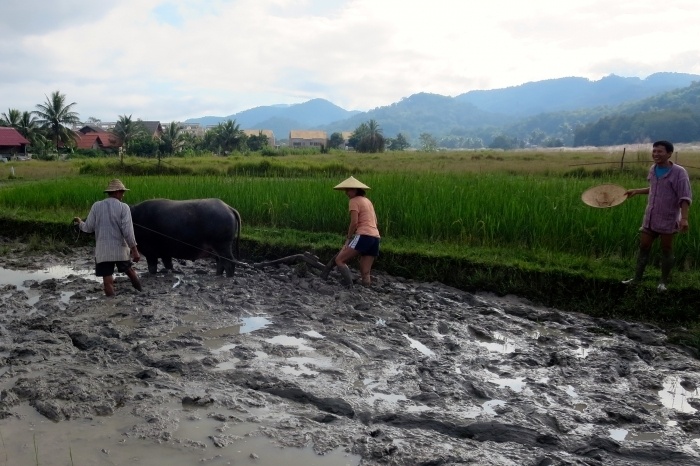
These days, most farms use machines to do the ploughing for them — a very different type of mechanical bull than you may see back in the USA!
4. Transplant the Seedlings
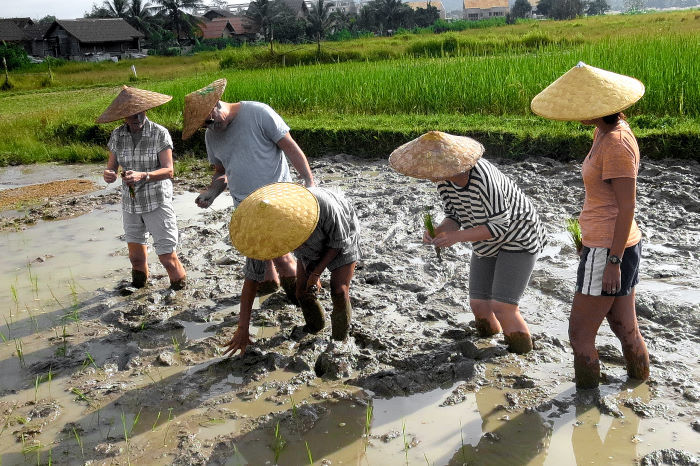
Moving the seedlings into the freshly-ploughed field can take awhile, so families often sing while they’re working the field. I’ve previously read studies that playing music can actually help plants grow, but in this case our group was so bad, I think the rice plants didn’t stand a chance at survival.
5. Water and Weed
As all good gardeners know, it’s necessary to weed and water your plants as they grow. The Living Land Farm uses irrigation to automatically water their fields and simply closes off fields by blocking the canals with mud. It’s a simple and effective technique.
6. Harvesting
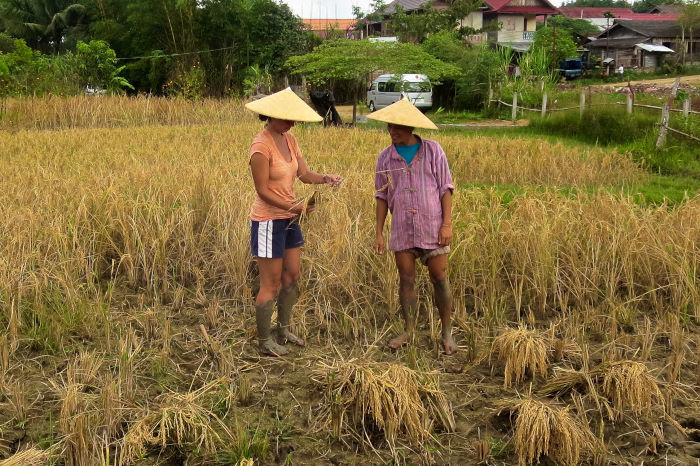
Farmers keep a close eye on their rice crop because harvesting must be done at a specific point or else the grains will fall into the paddy, rendering them unusable. There’s no way to delay a harvest, so you just have to be ready when the time is right. Irrigation to the paddy is cut off, the stalks are cut near the base using a sickle, and then left to dry out in the sun for a few days.
7. Thrashing
When the rice is dry, the grains are thrashed against a board. Tirelessly, Laut beat stalk after stalk using a set of batons to release all the grains, then expertly tossing the stalks aside. If you’re wondering, I was absolutely terrible at this step.
8. Cleaning
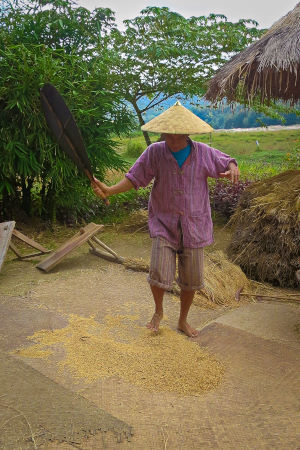
Unfortunately, as you thrash the stalks, a lot of straw and rice husks accidentally fall with the rice grains. Since these are much lighter than the grains, the easiest way to separate them is to use a fan to blow the straw away, leaving the kernels on the mat. If you do it right, this looks almost like a dancing motion.
9. Packing and Storing
Forty pounds at a time, rice is loaded into baskets to be transported into homes or storage. Laut showed us three different styles of baskets they use to carry the rice, but nothing changes the fact that it can be back-breaking work to carry 40 pounds of rice at a time, all day long.
10. Husking
Amazingly, the Living Land Farm still doesn’t use machines to release the husks from the grain of rice. They use a foot powered device to help with this work.
11. Separating Grains from Husks
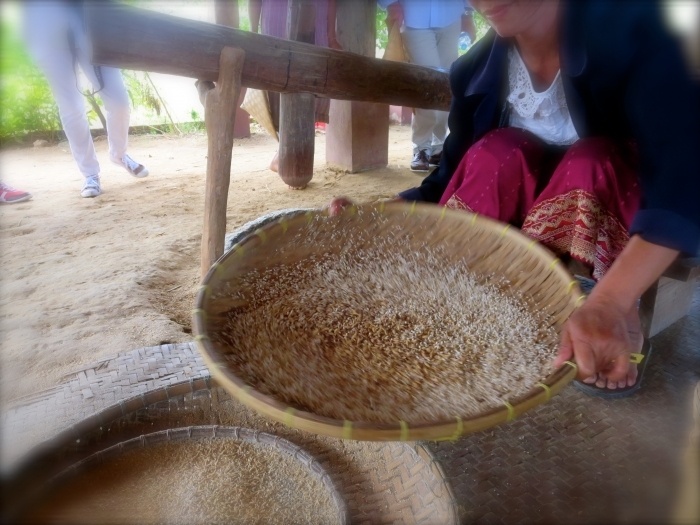
In the previous steps, the husks were physically removed from the grains, but you still need to sort the edible grains away from the husks themselves. If you picked them through by hand, you’d never finish, so women use woven bamboo trays to move the rice around until all the lighter husks have flown off. This skill is one that needs lots of practice if you don’t want to just throw everything around and make a big mess.
12. Soaking Rice
All sticky rice (the Lao staple) needs to be soaked before cooking. Overnight is best, but if you’re in a rush, a mere six hours will be good enough in a pinch.
13. Cooking
Sticky rice is steamed, never boiled (or it gets too sticky). They use a bamboo basket that sits on top of a pot of simmering water. The rice, in one big ball, is flipped about halfway through cooking rather than being stirred. Locals have perfected the art of flipping and cooking rice — after all, every person eats about 45 pounds of sticky rice per month!
14. Feasting
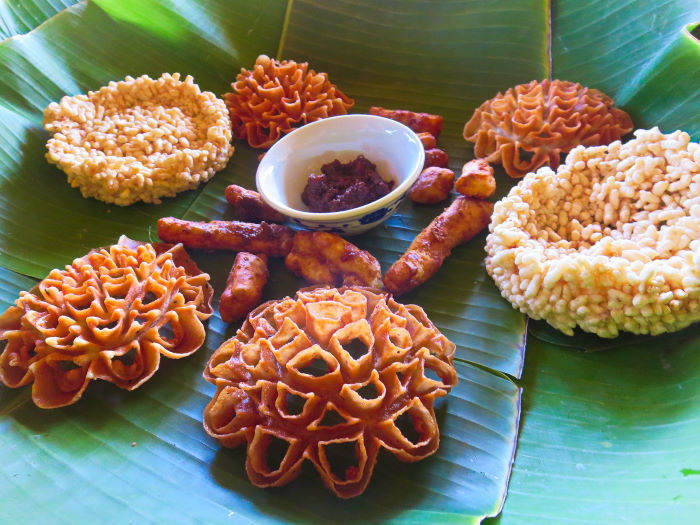
At the end of the tour, I was sweaty, hungry, and exhausted. I knew exactly what it takes to farm rice and I knew that every ingredient on my plate was fresh and organic. This would be the best rice I ever ate…and I still didn’t like it. We sampled sticky rice, rice crackers, puffed rice, and other treats. With the exception of the rice wine, I still wasn’t a fan (and let’s be honest: of course I was going to like the rice wine).
When I left, I had a profound appreciation for the amount of labor that goes into producing rice. And even though I still don’t like it, at least you can’t say I didn’t give it a fair shot.
If you go…
Be prepared to get dirty! If you don’t climb into the mud and participate, you’re missing half the fun. There’s a foot shower to wash up in afterwards, so don’t be afraid of the mud.
Tours are offered most mornings and in addition to the rice experience, you’ll also tour their organic vegetable garden, watch blacksmiths, bamboo weavers, and press your own sugarcane juice. It’s a full morning with about 4 hours of activity.
The Living Land Farm has a website and advertises direct bookings, but they weren’t responsive by email so instead I booked through Backstreet Academy, who I highly recommend (booking via my link provides a $10 discount off your first booking and also provides a credit to me). The agency offers lots of hands-on, culturally immersive experiences to choose from throughout Asia. Tours cost 340,000 kip, or about US $40, including tuk-tuks to and from the farm and your rice-based meal and plenty of bottled water.
This was a highlight of my trip to Laos and I highly recommend making room in your schedule for this tour! If you’ve got more time, check out my other favorite activities, including some in Vientiane and Vang Vieng.

Rice farming is hard work. Fortunately we left Lao before I was old enough to work in the field.
@MichaelP, I can’t imagine doing this every day, but it was very interesting to try it out for a few hours.